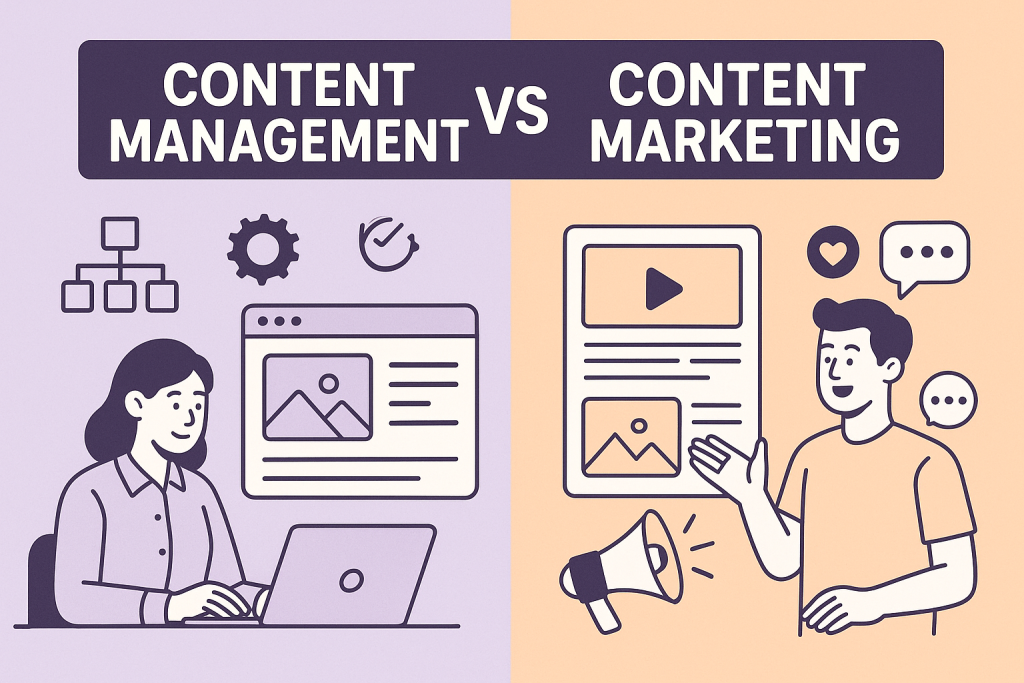Imagine two spiders in a digital habitat. One spins a meticulous web, then lies in wait for visitors. The other, one of the active searchers of the firmament (the land) continues to direct travelers to its booty, the silk. This image illustrates the fundamental distinction between content management and content marketing — two strategies which are all too frequently confused for each other.
For content management see that keyphrase research and strategy are critical. You could be talking about blogs, videos or podcasts that are intended to provide specific answers. It’s there, like a well-made trapdoor, when the audience comes looking for an escape. The goal? To offer enduring value that causes readers to come back.
The marketing is a more affirmative statement. It’s the flare that fires from your screen and yells, “Hey, over here!” via email campaigns or social newsletters. And rather than hoping that potential customers will come back, it intercepts them where they already are — scrolling through Instagram or checking their email.
Their approaches may be different but both are looking to deepen brand engagement. Management fosters trust with useful resources. Marketing should generate initial interest with targeted contacts. With each round, the two are combined, attracting attention and building intimacy over time.
Key Takeaways
- Content—They build the resources for audience looking; Marketing starts the conversation.
- Strategic development; you’re playing the long game, not the short.
- Material optimised to serve as 24/7 solution station
- Platform- and behavior-targeted proactive outreach.
- Two tactics working together that sustain themselves using the power of the audiences loop
What is the Difference Between Content Management and Content Marketing
Imagine a chef cooking food vs. a food critic who’s eater and writer—both are necessary, but very different things,” Salakhutdinov explained. Material is the “information, crafted with intent, and presented via media” (Margot Lester?). This is intentional work that turns raw concepts into the instruments that inform, entertain, and convert.
Defining Key Concepts
Strategic content creation essentially operates as a GPS for your ideal audience. A Q&A podcast or search optimized a blog as your company brain both implies leadership. Such assets are turned into permanent resources, and people can draw on them whenever you need solutions.
Digital Oureach builds on this basis. When one is about knowledge hubs, the other is about conversation starting where audiences already congregate. Email newsletters and social campaigns serve as friendly taps on the shoulder, not the less-assertive strategy of waiting around.
Content’s Digital Impact
When companies are justifiably bringing value, trust fills the vacuum. A blog reduces bounce rate and demonstrates expertise and a case study demonstrates tangible results in the real world. There are different formats for different purposes:
- Guides are teachers during the discovery phase
- Outline Webinar shows complicated solutions
Apos: Testimonies simplify the decision making process
This environment fosters engagement throughout the customer journey. First-stage materials lure consumers in, while retention-driven pieces keep brands top-of-mind. When strategy and execution come together, companies generate self-reinforcing cycles of discovery and loyalty.
Content Management and Content marketing: The fundamental differences.
Consider a trapdoor spider and a hawk who hunt in the same woods. One builds secret tunnels to capture prey that ventures in. The other keeps a watch on the horizon, swooping in when opportunities present themselves. These two different approaches reflect how companies manage information assets and outreach.
Intended Audience, Purpose, and Approach
Material engineered for search visibility functions as a 24/7 signpost. It satisfies questions people are already asking themselves — think tutorials introducing them to features of software or comparison charts between products. This is how we treat timelessness over trendiness.
Outreach efforts are more complicated. They break up thumb-scrolling trances with personalized messages on social feeds or inboxes. A skincare brand may poll Instagram about sunscreen habits, before posting educational reels. This approach creates connections before audiences know they have problems.
And How They Affect Brand Identity and Engagement
Helpful resources also make a business into a trusted partner. A bakery offering sourdough troubleshooting tips is now the authority on the subject. In the long run, it fosters organic loyalty — readers come back without being reminded.
Active-offensive character-building defines initial first impressions. Quizzes that are interactive or limited-time offers make for unforgettable experiences. They are sexier, but they can put brands into new communities. And combined, these two approaches parallel the full cycle of a relationship: earning interest and enhancing trust.
Content Management Tools and Platforms
Imagine trying to construct a city where every road smoothly connects, and that’s what today’s digital infrastructure demands. Web Content Management Systems (WCMs) or is where this is controlled, everything from blog to IoT device displays. These are platforms that allow teams to create once and publish everywhere, in the same way we can send a recipe to an oven and a billboard at the same time.
- The landscape of web CMS products
- The best WCM solutions are digital creator’s Swiss Army knives. They manage:
- Multi-site and app publishing on multiple channels
- Role based permission of workflow approvals
- Machine translated into global languages
HubSpot states that 24% of marketers are unable to select the right technologies.
The best ones eliminate the guesswork with drag-and-drop editors and real-time collaboration. It means that there is not a chance anyone is going to write on top of your masterpiece of a blog draft.
Choosing Tools for ProducingContent
- Choosing a platform shouldn’t be about shiny features — it should be about solving real problems. Ask:
- Is it scalable as your audience grows?
- Will it play well with your email service or CRM?
- Will even the least tech-savvy person in your office feel comfortable using it?
Focus on organization utilities that can automate pointless work. Seek out systems that provide performance analytics in addition to creation tools. Less time logging inMany many decades less time logging in as platforms talk to each other and you spend less time logging in and more time creating meaningful content.
Content Marketing Strategies and How to Distribute it to be Effective
Imagine a radio tower broadcasting signals compared to DJs spinning tracks in crowded nightclubs. One finds its audience among people who tune in on purpose; the other takes beats to where people are naturally hanging out. This opposition forms the backdrop to how materials are introduced to audiences through deliberate outreach activities.
Harnessing Social Media and Digital Channels
Different platforms require different approaches. Quick tips with bright visuals do well on Instagram Stories, but LinkedIn articles seem to prefer data-driven insights. According to HubSpot research 53% of marketers prioritize blogging – but those blog posts need to amplified by strategic sharing.
The timing matters as much as the format.
A/B test post schedules to prey on the people who use their phones to check the time commuting to work or use their screen as a distraction while putting baby down for a nap.
Platforms such as the Content Marketing Platforms (CMPs) tell you exactly when people are engaging and with what, and that makes all the difference.
Consistency builds trust. Editorial calendars organize quarterly themes with daily posts, creating touchpoints that maintain a sense of order instead of scrambling.
Shared dashboards allow writers, designers and analysts to work in unison in real time — no more version hell in email chains.
Reason of Workflow Automation There’s no need to waste human power handling repeat tasks.
CMPs can also automatically tweet blog links to Twitter or queue email follow-ups after signing up to a webinar. Now teams can concentrate on being creative problem-solvers rather than editors.
They’re amplification channels for your message. Review performance metrics to double down on whatever works — perhaps TikTok tutorials perform better than whitepapers for your SaaS product. Remain nimble, but allow data to inform decisions rather than chasing after every new idea.
Creating a Successful Content Strategy
Imagine your business as a cross-country car trip. Your Plan is your GPS—it establishes the route, fuel stops, and places to pull over for photos to make it to your destination in the most direct manner possible. A good plan maps every piece of content back to measurable results, taking you from random posts to growth path.
Matching Material to Business Needs
Begin with clearly defined goals. Looking to get 30% more webinar signups? Develop downloadable checklists that tease out great insights. Ready to Improve Customer Retention? Create an FAQ center to answer all the FAQs you receive that address common pain points. Strategically aligned then asks: “Does this blog/video/email directly relate to any of our quarterly focus areas.
Good plans are three steps:
- Assess current assets to identify gaps
- Expect new creation to a certain KPI们ccioneMap new creation to a specific KPI.
- Measure performance monthly
Companies that indicate they have a strategy are 313% more likely to post success.
Editorial calendars help keep teams focused on what matters rather than what’s shiny in the moment.
Creating a Consistent Brand Voice
You get noticed for the consistency. Whether a person reads a tweet or sees a tutorial, your messaging needs to resonate. Develop guidelines covering:
Tone (friendly expert v. casual ally)
Context (technical language vs. everyday language)
Look (colour, font, image)
A skincare company could use playful emojis on an app like TikTok while exercising professional clarity in whitepapers.
The core message remains intact — science-backed solutions for sensitive skin — with adaptations to fit platform norms.
Documentation prevents drift as teams scale. Keep voice guidelines in a location where everyone can access them and review it quarterly. Strategy and style combine to transform casual visitors into passionate advocates of companies.
We Want Mothers: And When Management is Marketing , Agreed.
Consider a championship sports team where defenders guard the goal and forwards score. The two teams function in tandem, applying different techniques en route to success. This collaboration is analogous to how content development and promotional efforts partner with one another in effective digital marketing.
Bringing together teams and systems for a coordinated Campaign effort
Dismantling department silos begins with shared tools. Consolidated platforms make it so creators and marketing see the same data — from draft blogs to campaign analytics. A fashion retailer could sync their product catalog with social ads so that with any promotion their ad reflects what is actually in-stock.
Frequent cross team meetings are to avoid duplication of work. Designers understand which blog topics get traffic, while copywriters figure out which email subject lines open emails. These insights allow teams to coordinate their work around shared objectives such as lead generation or customer retention.
Systems that link build consistency. A travel company might connect their booking platform to email newsletters. When you read an article about “hidden gem destinations,” automated campaigns recommend personalized trip packages. This closed-loop approach transforms readers into travelers.
Three ways to enhance teamwork:
Leverage real-time, project management tools
Develop style guides for the two departments to agree on
Review joint KPIs weekly
When content creators and campaign strategists collaborate, brands get more than just one-off wins. (Each tweet, tutorial and target ad builds a lasting relationship, to paraphrase BTS, because teamwork makes the digital dream work.
Keys to Measuring Success: Analytics, Engagement, and ROI
Think of a gardener monitoring soil pH and measuring sunflower growth: Both measurements are useful, but they tell different stories. Winning in digital tactics is all about knowing which numbers show real impact (versus just activity on the surface).
Performance Metrics and User Interaction Recollection
In a digital world, analytics are your digital compass. Traffic spikes can be easily seen with tools like Google Analytics and Tracking202, but specialized platforms can though. Content Marketing Platforms (CMPs) demonstrate how individual articles impact the number of people who sign up for your newsletter or request a product demo.
Focus on three key areas:
- Behaviour flow: After reading your guide, and where do visitors click?
- Time spent: Pages that keep people’s attention for 3+ minutes indicate value.
- Conversion paths: Blog post to purchase in under 4 clicks
One fitness brand discovered that tutorials with calorie counters overlaying the video led to 23% more app downloads than traditional workouts. The new information has upended their entire production schedule.
How do you measure them? An ROI is more than we think. Track how engagement lowers support tickets — if 1,000 readers turns to your troubleshooting guide, that’s how many hours saved for your team. Couple a few hard quantitative stats and qualitative feedback surveys A*”H style for complete and whole picture insight.
Keep in mind: Metrics should answer “So what?” If a viral tweet doesn’t ultimately lead target customers back to the brand, then it’s all noise. Tighten Reins on Every Chart and Graph Waterfall Align every chart and graph with strategic goals, whether establishing authority or accelerating sales.
Conclusion
Represent the relay runners handing off batons, strategic material systems and outreach campaigns relay to meet at the finish line of your business race. One creates the infrastructure — structured blogs, SEO-optimized guides — the other jump-starts growth through social media sparks and email boosts.
Winning WC teams have these tactics working like cogs in a system. For example, a cooking brand could house recipe videos in a digital library while funneling visitors to their site through TikTok challenges. This harmonic cycle is where marketing campaigns keep bringing new people to the evergreen resources.
Three rules for lasting consequences:
Align tools to team use cases – Prioritize tools that make creation and distribution simple
EA-Approved metrics – Measurement of what matters – How assets impact customer decisions
Stay driven by the audience – Update content as market trends change
Regardless of whether you’re honing your brand’s voice or experimenting with new channels, focus on quality material while allowing strategy to inform adaptability. Make your customers the center of all your decisions, and you’ll see relationships grow with every useful blog article or interactive campaign.
FAQ
In what ways are the underlying objectives of content management and marketing?
Digital asset management is about organizing, storing and providing materials like blogs or videos. The goal of promoting those assets: to get them in front of audiences via campaigns, SEO and social media. One deals in logistics; the other in visibility.
Can a brand be successful choosing one over the other?
It’s possible in the short term, but long-term success can be achieved only in syzygy. There are tools such as WordPress, which make it easy to produce the content, and platforms like HubSpot to distribute the content. The danger in dividing the two is the potential for mixed or lost messaging.
Which tools are necessary to streamline workflow?
Platforms such as Adobe Experience Manager have made it easier to store and update these. Semrush or Hootsuite track engagement for campaigns. When you provide both, you can guarantee a publication & Reach numbers.
What makes social media so important for contemporary campaigns?
Instagram, LinkedIn and other sites allow for direct interaction with viewers. They extend reach, build loyalty and offer instant feedback – crucial when it comes to perfecting strategies and maximizing ROI.
In what ways editorial calendars increase consistency?
They coordinate teams around deadlines, topics and distribution channels. Platforms like Trello or Asana prevent overlap, maintain brand voice and timing across blogs or newsletters.
What are the key ROI metrics?
Monitor performance engagement rates, conversion paths and bounce rates. Google Analytics shows how users are behaving, and via A/B testing on Mailchimp you can discover what emails are driving sales or sign-ups.
What if you have a small business?
Absolutely. Low-cost CMSes like Wix take care of the basics, but targeted ads on Meta or TikTok strain budgets. Mission-oriented work builds authority — not big teams.
How does SEO intersect with each of these sections?
Tagged and optimized pages (Yoast, Moz) are a benefit for SEO. Then marketing uses those rankings with backlinks or guest posts, tugging us up, creating a growth loop.







